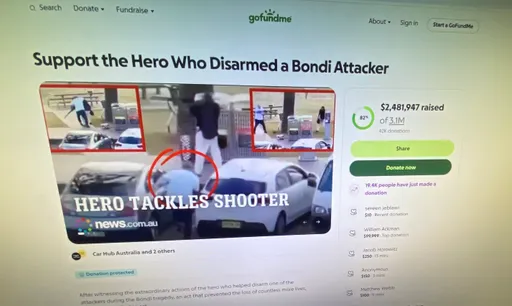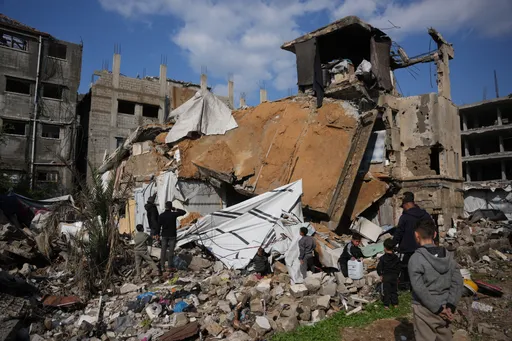NEW YORK — When Karina Clough, 29, was four years old, the Soviet Union was collapsing. Her family had a history of being the underdog in today’s Ukraine; her grandfather was a Baptist preacher who was exiled to Siberia for 15 years in the early 1960s, and her father’s Armenian heritage made it hard for him to find work. So in 1984, Clough’s parents took out their one-year savings, sold their house, packed a few bags and bought a ticket to Cuba.
They stopped in Canada for a layover, where the family decided to seek asylum but was denied. The Iron Curtain fell in 1991, about seven years after Clough’s family arrived in Canada. Though she had learned some French, she was without documentation, and their options in Canada were limited.
With the breakup of the Soviet Union, new nation-states refused to recognise some of their citizens due to strict citizenship policies. At least 680,000 stateless people live in Europe. Ukraine failed to recognise them as citizens in part due to their new citizenship laws and the fact that they lacked proper documentation when they fled. From this moment onwards, Clough became a citizen of nowhere.
There are approximately 4,000 stateless people living in the United States, but the number could be much higher given that there is no mechanism to monitor the population. Stateless people live mostly in the shadows, unknown even to each other. Yet they are impacted by changes to a variety of programs and policies, such as DACA and immigration detention practices.
Despite their small number, stateless people in the US are banding together to try to insert themselves into the national debate around immigration reform.
They must first, however, find each other.
“When people think of stateless people they think of people in refugee camps,” said Clough.
Women who look like her, who teach spinning classes at a gym in Philadelphia and are training to become doulas, are not the face of The UN campaign to end statelessness by 2024.
The 1954 United Nations International Convention defines a stateless person as someone who isn’t considered a national by any state under operation of its law. The Convention upholds the right to freedom of movement for stateless people through identity papers and travel documents, as well as a naturalization process. The High Commission for Refugees estimates there are more than 10 million stateless people in the world.
The US doesn’t create stateless people because it guarantees citizenship by birth on US territory. But so far, it doesn’t offer a legal framework that delineates a path to naturalization for those who become stateless on American soil. While the country’s citizenship laws are in alignment with international standards, it is not a signatory of the 1954 and 1961 international conventions.
People become stateless for a variety of reasons. Statelessness is sometimes a product of discrimination based on ethnicity or religion, like in the case of one million Rohingya in Myanmar, 700,000 Burkinabes in Cote d’Ivoire, and over 100,000 Dominicans of Haitian descent. It can also be the product of gender discrimination, like with the 25 states that don’t allow women to transfer nationality to their children, such as Saudi Arabia, Qatar and Lebanon. The creation of new states, transfers of territory and gaps in nationality laws also beget statelessness.
Clough grew up oblivious of her immigration status until she reached college and realised she was undocumented, since her parents brought her to the US without permission, and on top of that, stateless.
“It’s a mindf*ck,” she said. Clough didn’t have a form of valid ID that would allow her to get married in the state of Pennsylvania. She didn’t have a passport to travel and didn’t have a social security number to apply for federal aid to pay for school.
In 2014, Clough acquired her first form of legal ID when she received Deferred Action for Childhood Arrivals (DACA) and stopped carrying her laminated soviet birth certificate.
The endless struggle
“Stateless people are extremely hard to find; it’s a matter of luck,” said Nikolai Levasov, 36, in a thick Russian accent in an interview in a cafe in New York. He spends his time chasing ghosts. “Once you reach the 40th Google page search, that’s when the lives of stateless people begin.”
Levasov, who is of Russian descent, became stateless after Estonia gained its independence from the Soviet Union. At the time, Estonia granted him a residency card and an 'alien’s passport,' but he still couldn’t exert his full rights. He couldn’t vote in parliament, access state jobs, purchase land or work in other EU member countries. Then in 2004 his university in Estonia changed the curriculum from Russian to Estonian. From one day to the next, he could no longer understand a single word that was spoken in the classroom. For someone who has never had a state provide him basic rights and protections, the US promised some relief.
Levasov arrived in the US with a student visa that eventually expired. He overstayed his visa and kept renewing his alien’s passport until 2012 when the Estonian consulate rejected his application. This is when he reached “the point of no return,” he said.
He spends a lot of his time online typing “stateless” into search-engines and monitoring Russian-language immigrant forums. He shows up at immigration panels and calls and emails advocates, lawyers and experts. He knows the big players in the field of statelessness in North America and Europe.
His initial advocacy “was a big disappointment,” he said. Many immigration groups “would say this is not an American issue or that it is not part of their agenda, so I got more and more pissed off.” Levasov took matters into his own hands and found Clough and a couple of other people in similar situations. His efforts have culminated in the creation of United Stateless, a small network of stateless people and their allies working closely with international human rights groups and think tanks.
Stateless people also live in fear, since they are criminalised in the same way undocumented immigrants are treated by immigration authorities. In 2015, Levasov managed to fix his status when he married a US citizen, although this is not the case for every stateless person. This protection emboldened Levasov to lead the movement. “I felt safe and decided to share my story,” he said. “I think that people who have escaped this situation have less to lose.”
In the current political climate, it is not impossible to deport a stateless person, as happened to Mamadu Balde, a refugee deported to Sierra Leone last October after the Trump administration threatened sanctions against four countries if they didn’t accept deportees from the United States. Balde was sent back after 18 years, even though Sierra Leone wouldn’t accept him as a citizen.
For many in the group, this was the first time they met another stateless person. It can be an isolating experience in the US.
“We try to do the best we can to fit in,” said Marko over the phone. The 29-year-old sits in a crowded cafe in Chicago. The chatter in the background drowned his dimmed voice coming out of the receiver, but did not manage to erase the despair infused in his tone.
Marko has been stateless his entire life. Like his parents and grandparents before him, he has not been recognised as a citizen anywhere. He is Roma, a nomadic ethnic minority in Europe that has been historically disenfranchised. Born in Holland and brought to the United States by his parents at the age of two, he couldn't gain residency status in Holland.
“It's really hard to build a life [here],” he continued. “There is no such thing as a normal life for stateless people,” he said. “It’s a lot like PTSD; every day is a struggle to stay motivated and keep going.”
The lingering threat
United Stateless has had Skype calls in the last few months with people around the country. Their meetings act as both a support group and strategy session, where they discuss how to organise, do community outreach, talk to the media and invite other stateless people to share their stories. For many, it was the first time that they were meeting other stateless persons.
Together, they hope to push forward policy and legislative fixes.
“Statelessness suffers from the problem of not being enough people,” said David Baluarte, law professor at Washington and Lee University. “I don’t think there will be any way there will ever be enough political will to get a standalone bill to help stateless people. The only way it would be addressed through legislation is going to be as a part of a comprehensive reform bill.”
Baluarte’s 2013 report on statelessness in partnership with the Open Society Foundation and the United Nations High Commissioner for Refugees urged the White House to work with the Department of Homeland Security to grant deferred action on deportation to stateless people, as well as temporary permission to reside in the United States. It also recommends that Homeland Security provide identity and work documents, authorisation to travel, and “timely” release of stateless people from immigration detention — even after a deportation order — and a limit of ICE orders of supervision. (The Department of Homeland Security and ICE did not respond to requests for comment about whether they had considered or implemented any of the recommendations.)
The US Senate also proposed a mechanism for the protection of stateless persons under the Immigration and Nationality Act as part of its 2013 comprehensive immigration reform bill, a proposal that has resurfaced periodically. Under the current administration, however, advocates see little chance of that being included in new legislation.
“There’s the politics around immigration,” said David Baluarte, law professor at Washington and Lee University and author of the 2013 report. “Any proposal to give any group of people a path to citizenship meets opposition, that’s just the reality no matter how small the group. It’s a question of principle for anti-immigrant types.”
Comprehensive immigration reform doesn’t favor those on the fringes of immigration debacles, said Baluarte, be it stateless people, children born to US soldiers stationed abroad, international adoptees or many others whose situations are still obscure.
“We are so small and need more than us involved. We need people that are citizens,” said Clough. “They have voting power. Their voice is more powerful when it comes to legal change.”
Clough broke her silence about her status when Trump first threatened to rescind DACA. At the moment, Congress is at a standstill trying to come up with a legislative solution for the 70,000 so-called Dreamers.
“The best way to deal with this is to be vocal. I don’t want to be stateless forever,” she said.
“I don’t want to be deported; I want to be here.”
























